Discover Toronto's history as told through its plaques
2004 - Now in our 15th Year - 2019
To see what's new on this site, you can visit the Home Page
Looking at this page on a smartphone?
For best viewing, hold your phone in Landscape mode (Horizontal)
Victoria Memorial Square
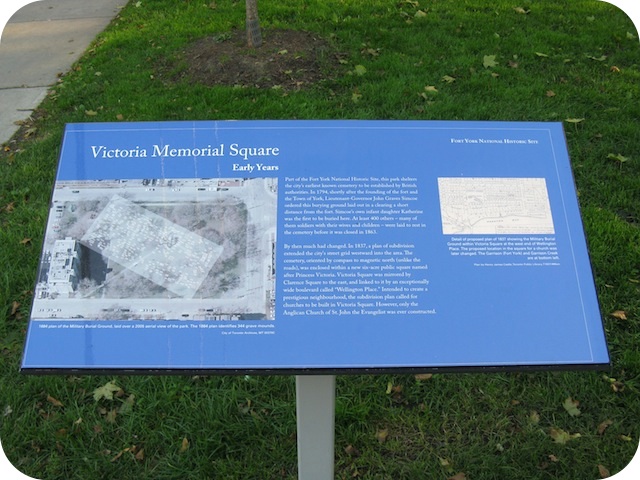
Photos and transcription by contributor Wayne Adam - Posted October, 2011
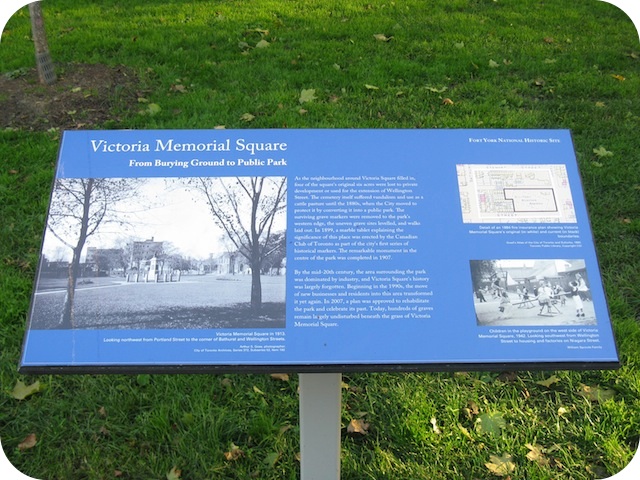
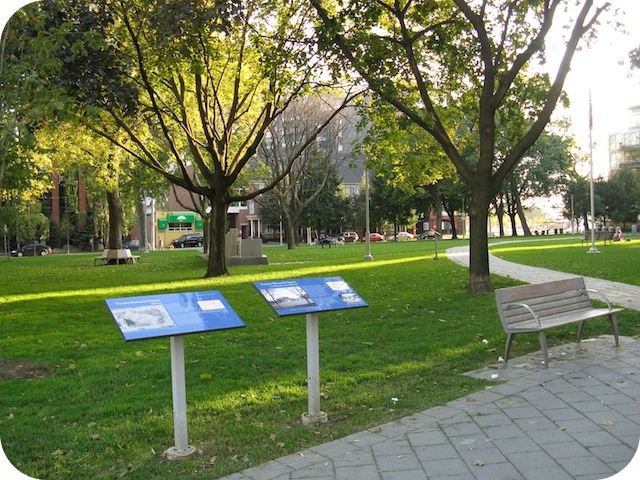
Located at the southwest corner of Wellington Street West and Portland Street, a block east of Bathurst Street, is this Square. There are many plaques here. This set of two has this to say:
Coordinates: 43.64263 -79.40013 |
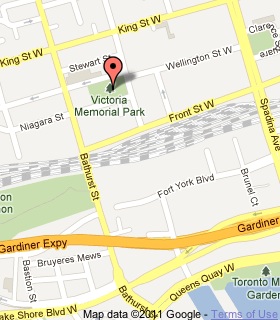 |
Early Years
Part of the Fort York National Historic Site, this park shelters the city's earliest known cemetery to be established by British authorities. In 1794, shortly after the founding of the fort and the Town of York, Lieutenant-Governor John Graves Simcoe ordered this burying ground laid out in a clearing a short distance from the fort. Simcoe's own infant daughter Katherine was the first to be buried here. At least 400 others - many of them soldiers with their wives and children - were laid to rest in the cemetery before it was closed in 1863.
By then much had changed. In 1837, a plan of subdivision extended the city's street grid westward into the area. The cemetery, oriented by compass to magnetic north (unlike the roads), was enclosed within a new 2.4 ha public square named after Princess Victoria. Victoria Square was mirrored by Clarence Square to the east, and linked to it by an exceptionally wide boulevard called "Wellington Place." Intended to create a prestigious neighbourhood, the subdivision plan called for churches to be built in Victoria Square. However, only the Anglican Church of St. John the Evangelist was ever constructed.
From Burying Ground to Public Park
As the neighbourhood around Victoria Square filled in, .8 of the square's original 2.4 ha were lost to private development or used for the extension of Wellington Street. The cemetery itself suffered vandalism and use as a cattle pasture until the 1880s, when the City moved to protect it by converting it into a public park. The surviving grave markers were removed to the park's western edge, the uneven grave sites levelled, and walks laid out. In 1899, a marble tablet explaining the significant of this place was erected by the Canadian Club of Toronto as part of the city's first series of historical markers. The remarkable monument in the centre of the park was completed in 1907.
By the mid-20th century, the area surrounding the park was dominated by industry, and Victoria Square's history was largely forgotten. Beginning in the 1990s, the move of new businesses and residents into this area transformed it yet again. In 2007, a plan was approved to rehabilitate the park and celebrate its past. Today, hundreds of graves remain largely undisturbed beneath the grass of Victoria Memorial Square.
Also located in Victoria Memorial Square are several other plaques all of which are shown on the rest of this page.
The Broad Arrow
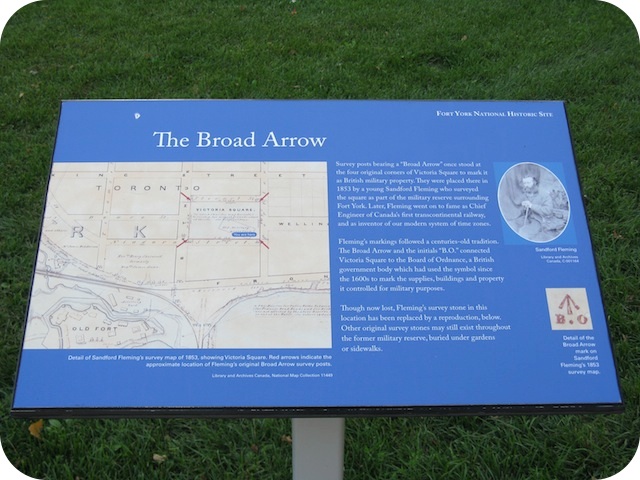
Photos and transcription by contributor Wayne Adam - Posted October, 2011
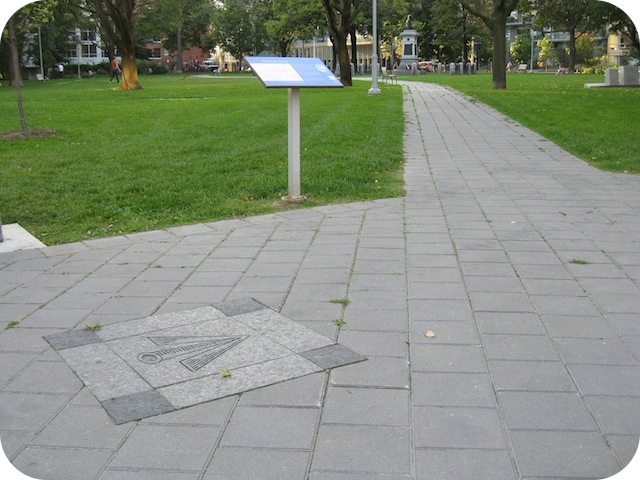
Here's what this one says:
Survey posts bearing a "Broad Arrow" once stood at the four original corners of Victoria Square to mark it as British military property. They were placed there in 1853 by a young Sandford Fleming who surveyed the square as part of the military reserve surrounding Fort York. Later, Fleming went on to fame as Chief Engineer of Canada's first transcontinental railroad, and as inventor of our modern system of time zones.
Fleming's markings followed a centuries-old tradition. The Broad Arrow and the initials "B.O." connected Victoria Square to the Board of Ordnance, a British government body which had used the symbol since the 1600s to mark the supplies, buildings and property it controlled for military purposes.
Though now lost, Fleming's survey stone in this location has been replaced by a reproduction. Other original survey stones may still exist throughout the former military reserve, buried under gardens or sidewalks.
War of 1812 Monument
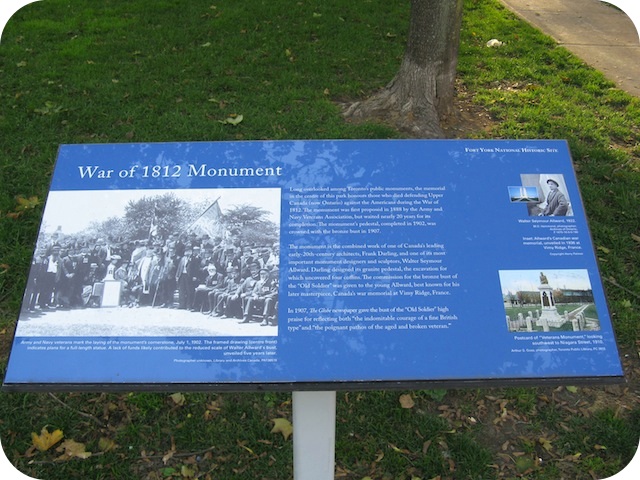
Photos and transcription by contributor Wayne Adam - Posted October, 2011
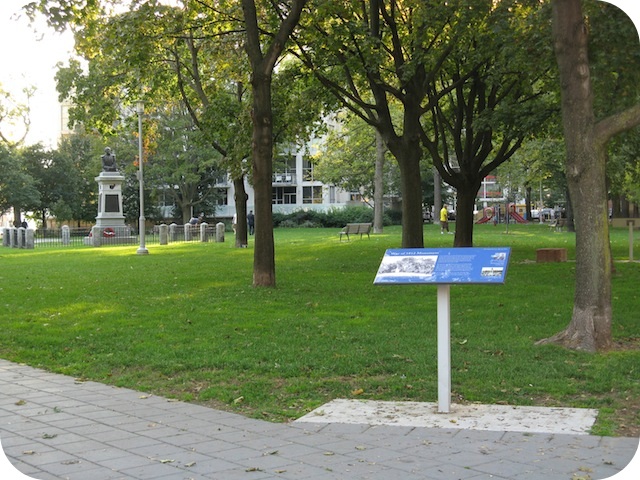
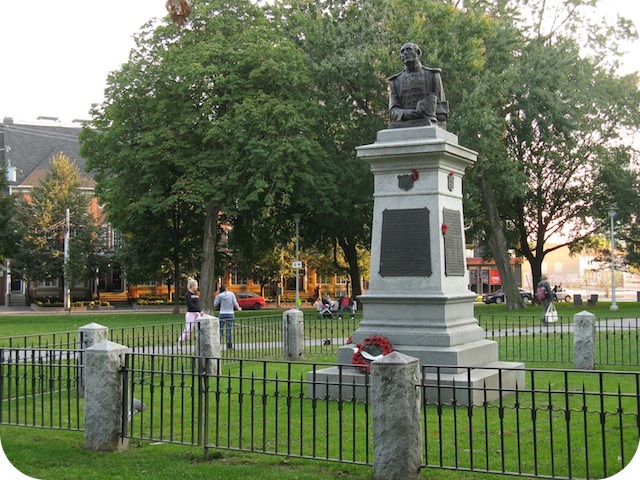
Here's what this one says:
Long overlooked among Toronto's public monuments, the memorial in the centre of this park honours those who died defending Upper Canada (now Ontario) against the Americans during the War of 1812. The monument was first proposed in 1888 by the Army and Navy Veterans Association, but waited nearly 20 years for its completion. The monument's pedestal, completed in 1902, was crowned with the bronze bust in 1907.
The monument is the combined work of one of Canada's leading early-20th-century architects, Frank Darling, and one of is most important monument designers and sculptors, Walter Seymour Allward. Darling designed its granite pedestal, the excavation for which uncovered four coffins. The commission for the bronze bust of the "Old Soldier" was given to the young Allward, best known for his later masterpiece, Canada's war memorial at Vimy Ridge, France.
In 1907, The Globe newspaper gave the bust of the "Old Soldier" high praise for reflecting both "the indomitable courage of a fine British type" and "the poignant pathos of the aged and broken veteran."
Church of St. John the Evangelist
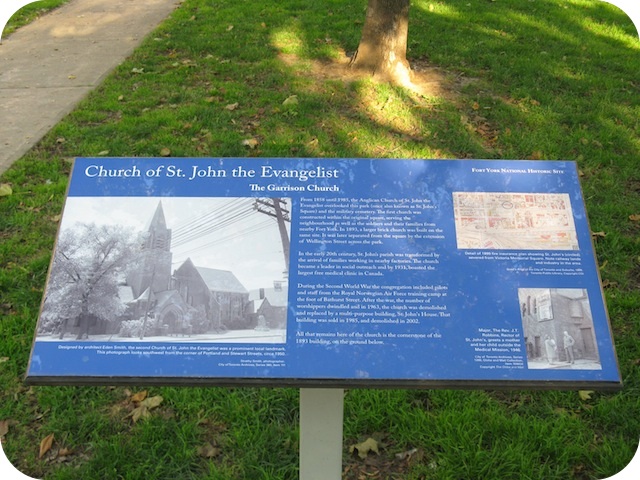
Photos and transcription by contributor Wayne Adam - Posted October, 2011
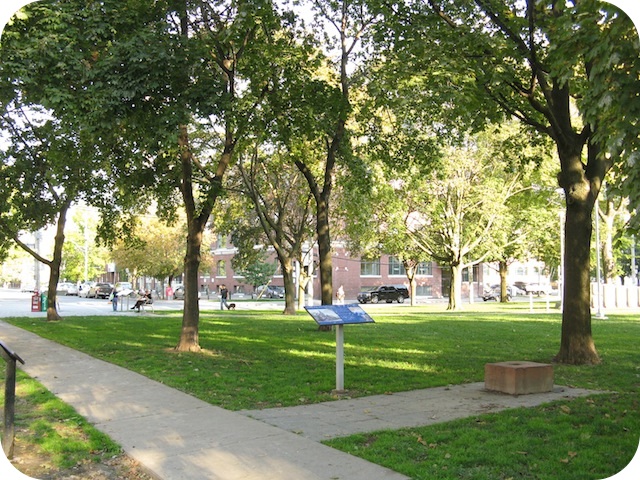
Here's what this one says:
From 1858 until 1985, the Anglican Church of St. John the Evangelist overlooked this park (once also known as St. John's Square) and the military cemetery. The first church was constructed within the original square, serving the neighbourhood as well as the soldiers and their families from nearby Fort York. In 1893, a larger brick church was built on the same site. It was later separated from the square by the extension of Wellington Street across the park.
In the early 20th century, St. John's parish was transformed by the arrival of families working in nearby factories. The church became a leader in social outreach and by 1931, boasted the largest free medical clinic in Canada.
During the Second World War the congregation included pilots and staff from the Royal Norwegian Air Force training camp at the foot of Bathurst Street. After the war, the number of worshippers dwindled and in 1963, the church was demolished and replaced by a multi-purpose building, St. John's House. That building was sold in 1985, and demolished in 2002.
All that remains here of the church is the cornerstone of the 1893 building, on the ground below.
Surviving Gravestones of the Military Burial Ground
Katherine Simcoe d. 1794, 15 months old

Photos and transcription by contributor Wayne Adam - Posted October, 2011
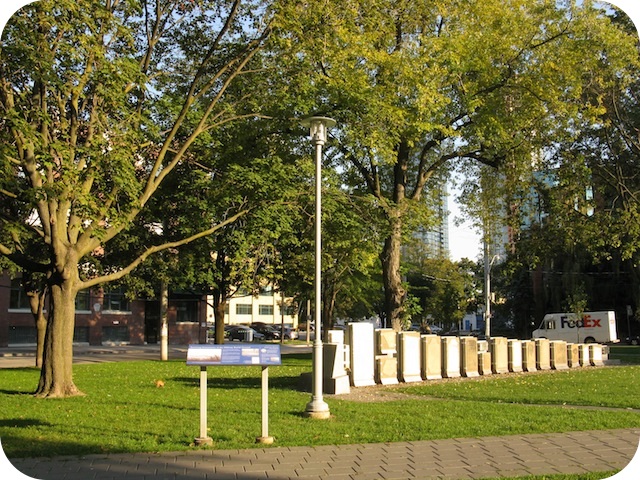
Photo by contributor Wayne Adam - Posted October, 2011
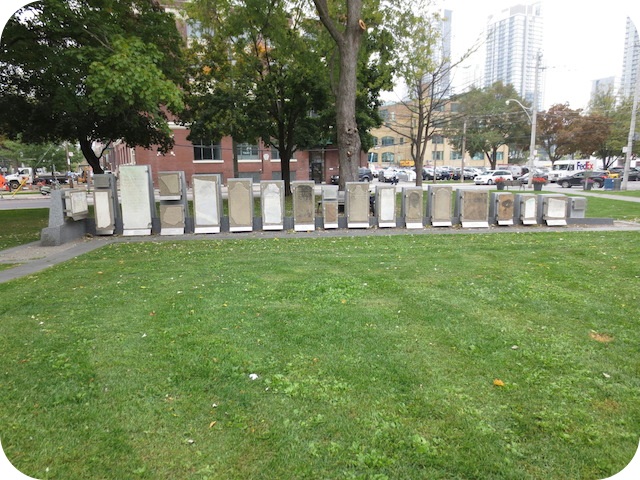
Photo by Alan L Brown - Posted October, 2006
Here's what this one says:
Created in 1794 and in use until 1863, the military cemetery in this park was once dotted with hundreds of markers. By the early 1880s, vandalism, weather and thieves had left only 35 stone, marble and wooden markers in their original locations.
We know important details about those markers from a study of the cemetery completed in 1884. Their inscriptions spoke to the harsh realities of the 19th century, reminding us that not only soldiers, but also their wives and children, were buried here.
When the cemetery became a public park in the 1880s, the grave markers were removed from their original locations and arranged on a terrace behind the present playground area. By the mid-1950s all of the wooden markers, and three of those made of stone, had disappeared. The remaining gravestones, most in poor condition, were laid in concrete at the foot of the War of 1812 monument.
In 2010, all 17 of the surviving stones were relocated here for their protection and interpretation. Twelve of them have been identified with certainty.
Katherine Simcoe, the seventh child of Lieutenant-Governor John Graves Simcoe and Elizabeth, his wife, was born in 1793 in what is now Niagara-on-the-Lake. She died only 15 months later in the Simcoes' tent-house at the edge of the wilderness near Fort York. In a letter to a friend in England, Elizabeth wrote of her daughter's death:
She had been feverish two or three days cutting teeth...on Good Friday she was playing in my room in the morning, in the afternoon was seized with fits, I sat up the whole night the greatest part of which she continued to have spasms and before seven in the morning she was no more... She was the sweetest tempered pretty child imaginable, just beginning to talk and walk and the suddenness of the event you may be sure shocked me inexpressibly.
Katherine Simcoe was the first to be buried here - on Easter Monday, 1794. The following year, a small marble gravestone was sent from England and placed on her grave. It read:
Katherine Simcoe
January 16, 1793 -
April 19, 1794
Happy in the Lord
Her gravestone had disappeared by the 1850s.
Here are some of the markers:
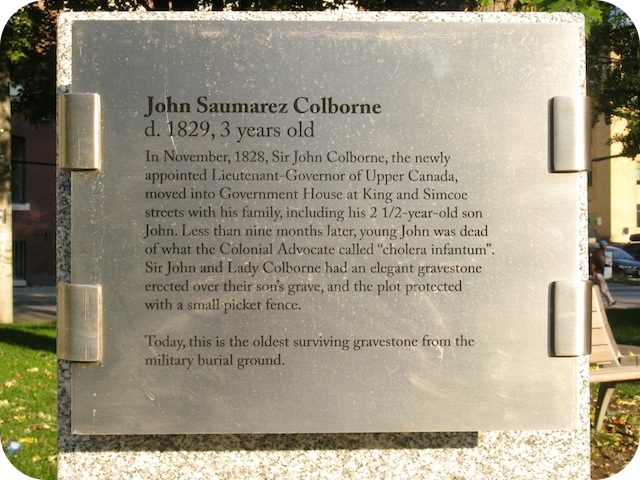
Photos and transcription by contributor Wayne Adam - Posted April, 2012
John Saumarez Colborne
d. 1829, 3 years old
In November, 1828, Sir John Colborne, the newly appointed Lieutenant-Governor of Upper Canada, moved into Government House at King and Simcoe streets with his family, including his 2 1/2-year-old son John. Less than nine months later, young John was dead of what the Colonial Advocate called "cholera infantum". Sir John and Lady Colborne had an elegant gravestone erected over their son's grave, and the plot protected with a small picket fence.
Today, this is the oldest surviving gravestone from the military burial ground.
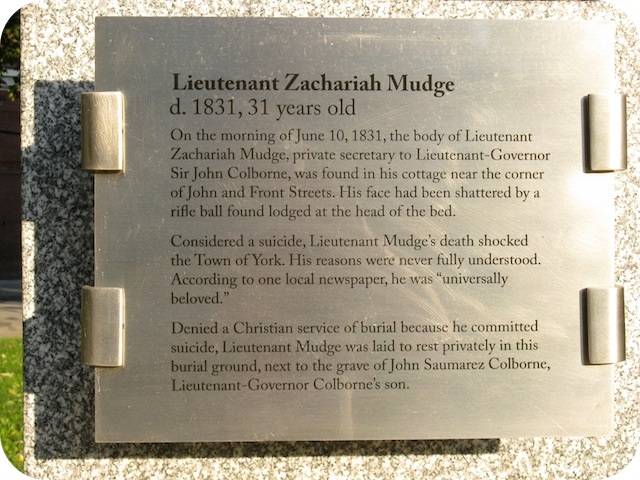
Lieutenant Zachariah Mudge
d. 1831, 31 years old
On the morning of June 10, 1831, the body of Lieutenant Zachariah Mudge, private secretary to Lieutenant-Governor Sir John Colborne, was found in his cottage near the corner of John and Front Streets. His face had been shattered by a rifle ball found lodged at the head of the bed.
Considered a suicide, Lieutenant Mudge's death shocked the Town of York. His reasons were never fully understood. According to one local newspaper, he was "universally beloved."
Denied a Christian service of burial because he committed suicide, Lieutenant Mudge was laid to rest privately in this burial ground, next to the grave of John Saumarez Colborne, Lieutenant-Governor Colborne's son.
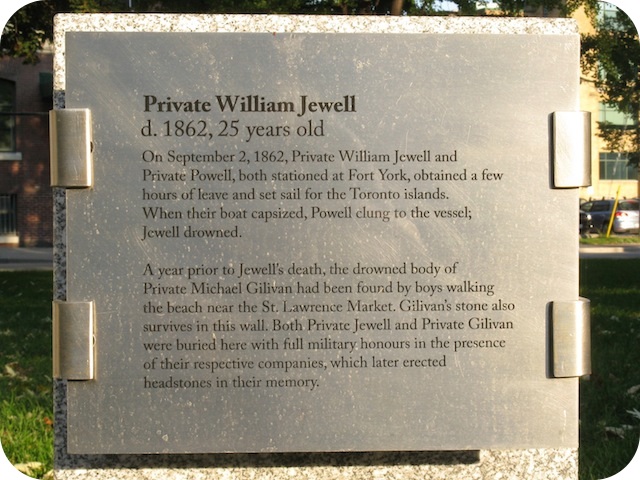
Private William Jewell
d. 1862, 25 years old
On September 2, 1862, Private William Jewell and Private Powell, both stationed at Fort York, obtained a few hours of leave and set sail for the Toronto islands. When their boat capsized, Powell clung to the vessel; Jewell drowned.
A year prior to Jewell's death, the drowned body of Private Michael Gilivan had been found by boys walking the beach near the St. Lawrence Market. Gilivan's stone also survives in this wall. Both Private Jewell and Private Gilivan were buried here with full military honours in the presence of their respective companies, which later erected headstones in their memory.
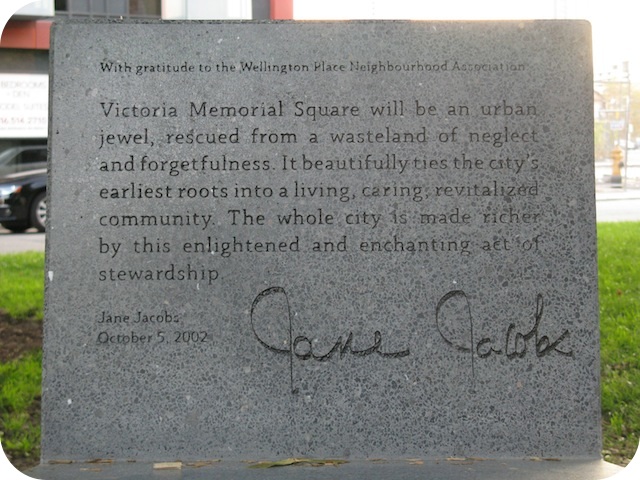
Photos and transcription by contributor Wayne Adam - Posted October, 2011
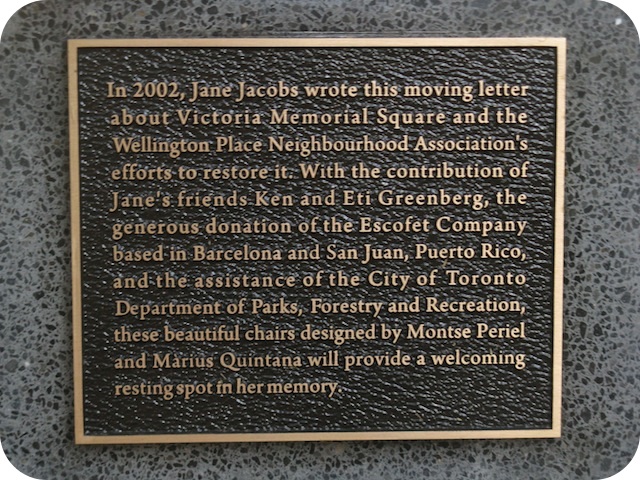
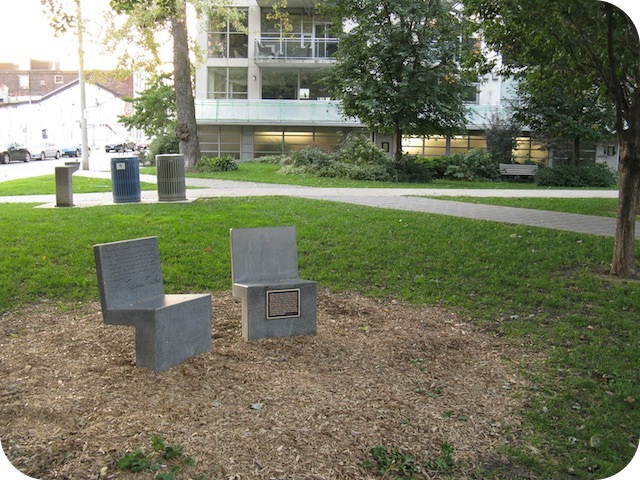
Here's what these plaques say:
With gratitude to the Wellington Place Neighbourhood Association
Victoria Memorial Square will be an urban jewel, rescued from a wasteland of neglect and forgetfulness. It beautifully ties the city's earliest roots into a living, caring, revitalized community. The whole city is made richer by this enlightened and enchanting act of stewardship.
Jane Jacobs
October 5, 2002
In 2002, Jane Jacobs wrote this moving letter about Victoria Memorial Square and the Wellington Place Neighbourhood Association's efforts to restore it. With the contribution of Jane's friends Ken and Eti Greenberg, the generous donation of the Escofet Company based in Barcelona and San Juan, Puerto Rico, and the assistance of the City of Toronto Department of Parks, Forestry and Recreation, these beautiful chairs designed by Montse Periel and Marius Quintana will provide a welcoming resting spot in her memory.
Related webpages
Victoria Memorial Square
Town of York
Queen Victoria
Canadian Club of Toronto
time zones
Broad Arrow
Upper Canada
Frank Darling
Battle of Vimy Ridge
Canadian National Vimy Memorial
Jane Jacobs
Other plaques at this location
The Old Garrison Burying Ground 1794-1863
Church of St. John the Evangelist (The Garrison Church)
Related Toronto plaques
The Battle of York 1813
The Birthplace of Standard Time
Church of St. John the Evangelist (The Garrison Church)
Colonel W.J. Stewart
The Defence of York
Fort York
Fort York
Landing of American Troops at York
Lieutenant-General John Graves Simcoe 1752-1806
Military Burial Ground
The Old Garrison Burying Ground 1794-1863
The Royal Norwegian Air Force 1940-1945
The Second Invasion of York
Victoria Memorial Square
Walter Seymour Allward, R.C.A., 1876-1955
The War of 1812 & the Siege of York
More
Parks and Recreation
Cemeteries
Here are the visitors' comments for this page.
(none yet)
Here's where you can send me a comment for this page.
Note: Your email address will be posted at the end of your comment so others can respond to you unless you request otherwise.
Note: Comments are moderated. Yours will appear on this page within 24 hours (usually much sooner).
Note: As soon as I have posted your comment, a reply to your email will be sent informing you.
To send me your comment, click [email protected].
Thanks
Webmaster
Note: If you wish to send me a personal email, click here.